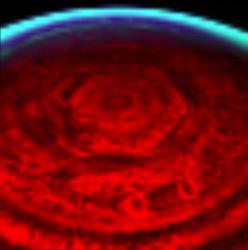The clouds surrounding the north pole of Saturn do not move in a circular orbit but in an orbit consisting of six straight lines
 In order to approximate a circle in an infinitesimally small way, one must draw a polygon with an infinite number of sides, each of which tends to zero. Saturn shows us that a hexagon can also be a substitute for a circle. Photos taken by Cassini revealed a strange configuration - a six-sided cloud structure that surrounds the entire North Pole. The structure was first discovered, but vaguely, by the Voyager spacecraft nearly 30 years ago, but new images from Cassini show it in detail.
In order to approximate a circle in an infinitesimally small way, one must draw a polygon with an infinite number of sides, each of which tends to zero. Saturn shows us that a hexagon can also be a substitute for a circle. Photos taken by Cassini revealed a strange configuration - a six-sided cloud structure that surrounds the entire North Pole. The structure was first discovered, but vaguely, by the Voyager spacecraft nearly 30 years ago, but new images from Cassini show it in detail.
This cloud structure is similar to Earth's polar vortex, but instead of a circle, the clouds formed a hexagonal configuration. The depth of this hexagon is about a hundred kilometers. This configuration only exists in the North Pole. At the South Pole there is a huge permanent storm, but it looks like a huge hurricane eye.
The Cassini spacecraft has so far been unable to photograph the North Pole because the area has been covered in winter until now. This image was taken in the infrared part of the spectrum, so the variation in color reflects variation in temperature. Like the North Pole of the Earth, the area is under a blanket of darkness for a long period of time. In the case of Saturn, 15 years of darkness. As spring progresses in the Northern Hemisphere, it will be possible to photograph the area in other light frequencies as well.
However, researchers still do not know what causes this mysterious shape.

6 תגובות
Eyal
One of the uses of the hive cells is to grow the larvae which are generally round. Besides, I don't think the bees are planning a hexagon. They generally build in circles and the adhesive forces between them form the hexagons.
There is no doubt that there is a reason for the hexagonal storm. Maybe one day we will know.
Aria, thank you for your attention. But why then don't the bees build square cells? On the face of it, it seems to me that square cells are much easier to build, and even with them there won't be any empty areas, what's wrong with that?
I'm sure there is a logical scientific explanation for the hexagonal structure of the snowflakes, as well as the hexagonal structure of the cells in the beehive, I was just trying to imply that maybe the exact same explanation can also solve the mystery of the hexagonal structure of the storm, maybe there too similar forces are at work only on a much larger scale big.
What I think can possibly explain this strange structure is an asymmetric pressure that is exerted on the storm in one of the areas and causes one of the "sides" to be pushed in (perhaps a large volcano, maybe something else) in order to maintain pressure balance the other sides are also pushed in at the same angle so that the pressures The commons will balance out, it's a very vague explanation, but that's what comes to my mind for now :-))
And the hexagonal structure of the snowflakes also has an explanation in the crystalline structure of the ice derived from the molecular structure.
Eyal
The bees build in hexagons because it is the closest to a circle and yet leaves no empty spaces.
For the most part I knew, nothing can be "prevailing in winter." Is it possible that the pole is frozen in winter?
Maybe you should ask the bees, they also build hexagonal cells inside the hive, it seems to me that many times snowflakes are also in the shape of hexagons, I wonder if they will manage to create some kind of computer simulation that will explain this strange thing!